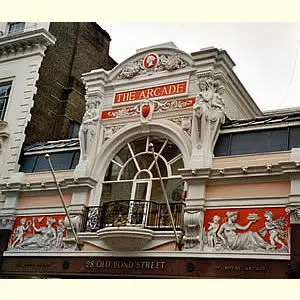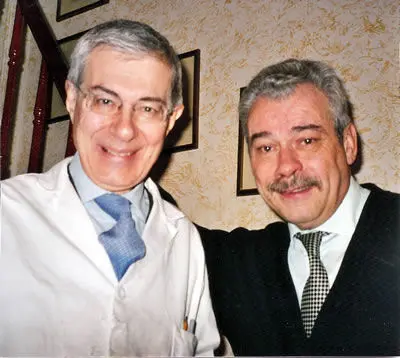


Great shoes must have two characteristics: lightness and elegance. And no shoes are greater than those made by George Cleverley & Co. My admiration for the bespoke footwear which leaves the firm’s shop in the Royal Arcade, just off London’s Bond Street, knows no bounds. That is because I admire skill, dedication and fine workmanship, and these qualities are crammed so tightly into this little place that it must surely one day burst at the seams. And I love that which is light and elegant. One day the thought came to me – I shall attribute it to Divine Revelation – that I should devise a pair of shoes which would be the perfect expression of all that is wonderful about Cleverley. This pair of shoes would be a work of art, as well as being entirely practical and – it goes without saying – wonderfully made. Thus did Providence lead me to the idea of bespoke black and white shoes.
George Cleverley himself (pictured, in black and white) is, of course, no longer with us, having passed to his eternal reward, full of honour and distinction, in 1991. But his noble legacy is brilliantly continued by his two pupils, George Glasgow and John Carnera (pictured). Mr Glasgow is a Londoner, born in Pimlico of Irish parents. Mr Carnera has family in Northern Italy, and is proud that his uncle, Primo Carnera, was the heavyweight boxing champion of the world in 1933 and 1934. Together, these gentlemen have ensured that the high standards set by the Great Man have been rigorously maintained. “Cleverley shoes,” we might say, “are still Cleverley shoes.” Only the finest materials are used – the leather for the uppers is from the Freudenberg Company near Cologne and that for the soles is oak-bark tanned at Bakers’ thousand year-old tannery in Devon. Much of the work – including the carving of the individual wooden lasts for each customer – is done on the premises.



Having had shoes made by Cleverley before, my wooden lasts reside upstairs in the last room at the Royal Arcade. This means that for my new shoes I could take for granted the perfect fit for which the firm is famous. But, of course, I needed to discuss the details. Thus did I find myself seated in the shop with the kindly and courteous Mr Carnera.
I have mentioned that the shoes would be black and white. But you will wish to know the precise details. The design would be what I consider to be one of Cleverley’s best: the Adelaide semi-brogue. They would be made in white calf, but with black perforated toe caps, black facings and black back-counters. The soles would be quarter-bare, with bevelled waists and close welts. Two rows of brads would be nailed into the toes, to reduce wear. The toe would be of the sharp square chisel shape. The heels would be 1⅛ inches high, tapered and with quarter iron tips. (This last feature ensures that I make the proper ‘clicking’ sound as I walk along.) Specially made shoe trees would be supplied to keep the shoes in shape.
And then I decided upon two further features, which would ensure aesthetic perfection. The shoes would be lined in red leather. (Yes, I know that the lining cannot be seen when shoes are worn, but neither can the red linings of my suit jackets. But there is pleasure to be had when one is dressing from a brightly coloured conceit.) And the toe caps – but no other parts of the shoes – would be ‘distressed’. This appearance of fading, when used with discretion, can be enchanting. It hints at age and the dignity of experience. In these particular shoes, I wanted it also to be a means of softening the contrast between the black and the white leathers.



Mr Carnera seemed to be as pleased at the prospect of making these shoes as I was at the prospect of wearing them. And thus, surely, it should be with bespoke shoes. At £3,600 a pair, bespoke shoes at Cleverley are not cheap. But, then, great art should not be cheap. Is the price good value? Most certainly, yes. For it brings a combination of the finest skill and the best materials which is too rarely found nowadays.
A couple of months later I returned to shop for a fitting. At this stage the shoes certainly do not look their best, but they do display some of their ‘insides’, and it is possible to look in wonder at what goes into something which most of us usually take for granted. Mr Carnera surveyed the fit with his expert eye, made some notes in his book and seemed satisfied in that way which marks out true craftsmen.
A month after this I was back to collect the finished shoes. I had wanted Lightness and Elegance, and there before me was the incarnation of those two virtues. And, even more remarkably, there was the marriage of utility and beauty. I hope you can appreciate this from the photographs, even if you must take my word for the fact that the shoes are supremely comfortable in the wearing.
Those of us who live in London are fortunate to have George Cleverley & Co. on our doorstep. But Mr Glasgow travels to the United States and to Japan, to ensure that the feet of the discerning in those countries, too, can be shod in the finest bespoke shoes in the world. For myself, I rejoice that my Cleverley shoes now include these magnificent examples of the shoemaker’s art. I shall wear my black and white shoes with pride.

13 The Royal Arcade, 28 Old Bond Street, London W1S 4SL, England.
Telephone +44 (0)207 493 0443 or 1058
Fax +44 (0)207 493 4991
Email: enquiries@georgecleverley.com
georgecleverley.co.uk
Bespoke shoes from £3,600 a pair, including wooden trees.
The ‘Anthony Cleverley’ range of ready-to-wear shoes uses bespoke grade leather with hand lasting, hand welting and hand finishing - £950 a pair, including wooden trees.
Visits are made to several cities in the USA. Ask for details